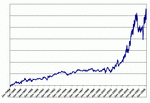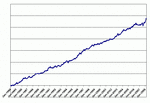Mathemagician
Established member
- Messages
- 603
- Likes
- 130
Why is it that most traders spend nearly all of their time chasing after a better set of entries and exits? (Heck, most focus squarely on the entries!) In reality, you can use pretty much any modestly stable set of entries and exits and achieve results that would please any trader whose goals are properly aligned.
In order to illustrate this I've attached two equity curves. They both use an embarrassingly simple entry/exit methodology found in a book that was published in 1998 (just a daily breakout). It's literally a two-line system, one for long entry and one for short.
The first EC is just the plain old system applied to a portfolio of 65 global futures markets using 1 contract each. The second EC is the identical set of entries and exits on the identical set of markets but with a halfway decent position sizing method applied. (Costs applied are $115 per round-turn.)
You'll note that the testing period is 25 years long with the last 10 years having occurred after the publication date. Notice there is no degradation in performance after the publication date. With position sizing turned on, this is a 21% compound annual growth rate with a maximum daily peak-to-valley drawdown of just 25%. This result is definitely competitive with the top CTAs and money managers for this period!
Once you outgrow the B.S. presented by the make-1000%-a-month-with-95%-winning-days hypesters and work out what a 21% CAGR means to you, you quickly realize that this type of performance is more than you'll ever need and the drawdowns associated with it are quite comfortable. Why do I say this? Well, here's a VAMI table showing the results of a 21% annual return compounded over a career...

That's right, after 10 years you've got a 670% return on initial capital, and after 20 years you've got a 4500% ROIC. Best of all, during this time the worst drawdown you've endured is 25%.
Why aren't more people trading this way? Why are so many people chasing the perfect entries? It's a mystery to me, but I'd sure love to hear your reasons...
jj
In order to illustrate this I've attached two equity curves. They both use an embarrassingly simple entry/exit methodology found in a book that was published in 1998 (just a daily breakout). It's literally a two-line system, one for long entry and one for short.
The first EC is just the plain old system applied to a portfolio of 65 global futures markets using 1 contract each. The second EC is the identical set of entries and exits on the identical set of markets but with a halfway decent position sizing method applied. (Costs applied are $115 per round-turn.)
You'll note that the testing period is 25 years long with the last 10 years having occurred after the publication date. Notice there is no degradation in performance after the publication date. With position sizing turned on, this is a 21% compound annual growth rate with a maximum daily peak-to-valley drawdown of just 25%. This result is definitely competitive with the top CTAs and money managers for this period!
Once you outgrow the B.S. presented by the make-1000%-a-month-with-95%-winning-days hypesters and work out what a 21% CAGR means to you, you quickly realize that this type of performance is more than you'll ever need and the drawdowns associated with it are quite comfortable. Why do I say this? Well, here's a VAMI table showing the results of a 21% annual return compounded over a career...
That's right, after 10 years you've got a 670% return on initial capital, and after 20 years you've got a 4500% ROIC. Best of all, during this time the worst drawdown you've endured is 25%.
Why aren't more people trading this way? Why are so many people chasing the perfect entries? It's a mystery to me, but I'd sure love to hear your reasons...
jj


